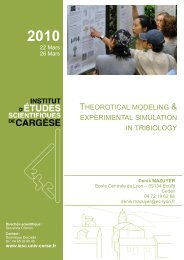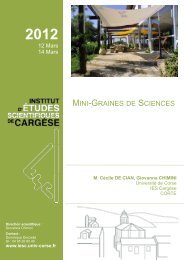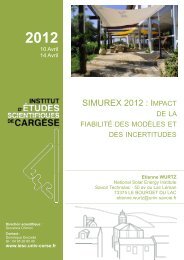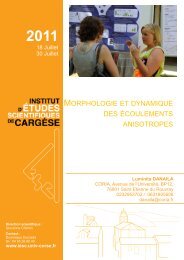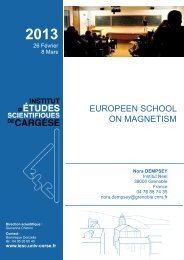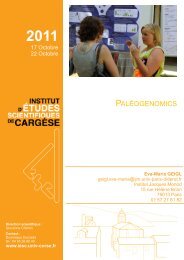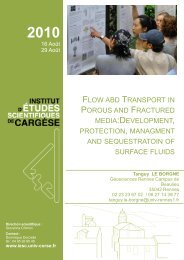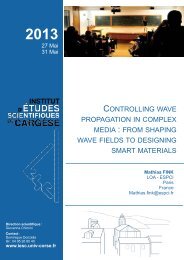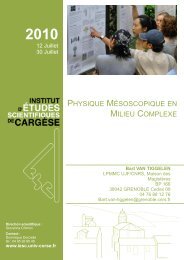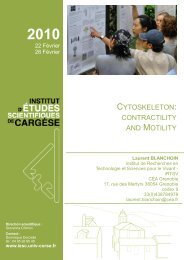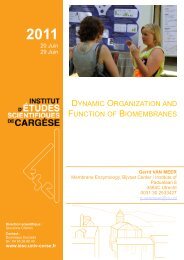nanoelectronics - Institut d'Études Scientifiques de Cargèse (IESC)
nanoelectronics - Institut d'Études Scientifiques de Cargèse (IESC)
nanoelectronics - Institut d'Études Scientifiques de Cargèse (IESC)
You also want an ePaper? Increase the reach of your titles
YUMPU automatically turns print PDFs into web optimized ePapers that Google loves.
Friday<br />
Friday, October 2<br />
Metallic phase of the quantum Hall effect in four-dimensional space<br />
Jonathan M. Edge, J. Tworzydlo, C. W. J. Beenakker<br />
Instituut-Lorentz, Universiteit Lei<strong>de</strong>n, P.O. Box 9506, 2300 RA Lei<strong>de</strong>n, The Netherlands<br />
<strong>Institut</strong>e of Theoretical Physics, Faculty of Physics, University of Warsaw, Hoza 69, 00--681<br />
Warsaw, Poland<br />
We study the phase diagram of the quantum Hall effect in four-dimensional (4D) space [1].<br />
Unlike in 2D, in 4D there exists a metallic as well as an insulating phase, <strong>de</strong>pending on the<br />
disor<strong>de</strong>r strength. The critical exponent ≈ 1.2 of the diverging localization length at the<br />
quantum Hall insulator-to-metal transition differs from the semiclassical value = 1 of 4D<br />
An<strong>de</strong>rson transitions in the presence of time-reversal symmetry. Our numerical analysis is<br />
based on a mapping of the 4D Hamiltonian onto a 1D dynamical system, providing a route<br />
towards the experimental realization of the 4D quantum Hall effect.<br />
[1] J.M. Edge, J. Tworzydlo, C. W. J. Beenakker Metallic phase of the quantum Hall effect in<br />
four-dimensional space arXiv:1206.0099 to be published in PRL (2012)<br />
__________________________________________________________________________<br />
Thermal metal in topological superconductors<br />
Jakub Tworzydlo (1) , I. C. Fulga (2) , A. R. Akhmerov (2) , C.W.J. Beenakker (2) , B. Beri (3)<br />
(1)<br />
Faculty of Physics, University of Warsaw, Poland<br />
(2)<br />
Instituut-Lorentz, Universiteit Lei<strong>de</strong>n, The Netherlands<br />
(3)<br />
TCM Group, Cavendish Laboratory, United Kingdom<br />
The thermal quantum Hall effect appears in the absence of time-reversal symmetry in a<br />
single layer of a chiral p-wave superconductor. The insulator-insulator transition associated<br />
with this effect is generically present only for weak disor<strong>de</strong>r. For stronger disor<strong>de</strong>r we find a<br />
transition to a <strong>de</strong>localized phase, known as the thermal metal.<br />
In contrast, for a helical superconductor in the presence of time-reversal symmetry the<br />
transition between two topologically distinct thermal insulators occurs via the intervening<br />
thermal metal phase, even for an arbitrarily weak disor<strong>de</strong>r.<br />
We present a <strong>de</strong>tailed study of a phase diagram and the critical exponents for these<br />
topologically induced transitions. We also point to an un<strong>de</strong>rling mechanism of Majorana<br />
states formation in both chiral and helical systems.<br />
[1] I. C. Fulga, A. R. Akhmerov, J. Tworzydlo, B. Beri, and C. W. J. Beenakker, Phys. Rev. B<br />
86, 054505 (2012)<br />
[2] M. V. Medvedyeva, J. Tworzydlo, and C. W. J. Beenakker, Phys. Rev. B 81, 214203<br />
(2010)<br />
[3] J. H. Bardarson, M. V. Medvedyeva, J. Tworzydło, A. R. Akhmerov, and C. W. J.<br />
Beenakker, Phys.Rev. B 81, 121414(R) (2010)<br />
[4] M. Wimmer, A. R. Akhmerov, M. V. Medvedyeva, J. Tworzydlo, C. W. J. Beenakker,<br />
Phys. Rev. Lett. 105, 046803 (2010)



